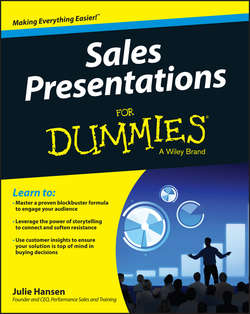Читать книгу Sales Presentations For Dummies - Julie M. Hansen - Страница 8
Part I
Getting Started with Sales Presentations
Chapter 1
Embracing the Future of Sales Presentations
Dealing with Potential Problems
ОглавлениеTexting during your presentation, prospects entering and exiting the room, technical difficulties, objections – can and will occur – when giving a presentation. How you deal with them determines whether your presentation gets back on track and running smoothly or ends up at the wrong destination.
These sections introduce you to a strategy for regaining your prospect’s attention after you lose it and for handling objections when they arise.
Maintaining engagement and focus
Attention isn’t constant. Planning to reengage your audience throughout your presentation is a necessity today. Luckily, certain things have the power to draw people’s attention. Leveraging this fact by using a variety of these different techniques throughout your presentation can keep your presentation fresh and your audience engaged:
✔ Introduce a prop. A whiteboard, flipchart, a product sample, even an ordinary object like a phone, or a book, can serve as a visual cue to regain your prospect’s attention and reinforce recall.
✔ Interact with your audience. Questions aren’t the only form of interaction; try taking a poll, running a contest with a cool but inexpensive giveaway, or giving someone in your audience a role in your presentation to regain attention.
✔ Use movement. Getting out of the comfort zone behind your laptop is crucial in order to form a connection with your prospect. Look for opportunities to approach your audience, like when you’re telling a story, posing a question, or discussing your prospect’s challenges. If you’re seated, use gestures to underscore your message and focus your prospect’s attention.
Check out Chapter 14 for more fresh ideas on keeping your audience engaged.
Handling objections
Although most salespeople would prefer not to get any objections, objections are actually a sign of an engaged prospect. What makes it uncomfortable is not having a good process in place for handling an objection. Here are some quick tips for dealing with objections in a way that moves the sale forward:
✔ Preempt an objection. The best defense is a good offense! Brainstorm possible objections and come up with a response for each type – price, timing, features – and diffuse the objection by including it in your presentation before your prospect has a chance to bring it up.
✔ Break up the objection. Objections can trigger your fight-or-flight instinct, negatively affecting how you respond. Before you jump to answer the objection, take a deep breath, break it down by listening, pausing, and then clarifying to make sure you’re answering the real objection.
✔ Say “yes and … .” This rule of improv is effective and easy for handling the toughest of objections. Simply acknowledge your prospect’s objection (say yes), add your perspective (with “and”), and ask an open-ended question to collaborate on a solution with your prospect.
Head to Chapter 15 for more suggestions on how to prepare for objections and handle them during your presentation.
